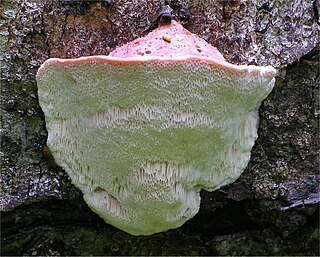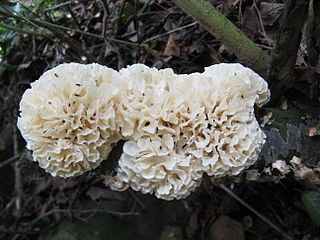
The Meruliaceae are a family of fungi in the order Polyporales. According to a 2008 estimate, the family contains 47 genera and 420 species. As of April 2018, Index Fungorum accepts 645 species in the family.

The Phanerochaetaceae are a family of mostly crust fungi in the order Polyporales.

The Steccherinaceae are a family of about 200 species of fungi in the order Polyporales. It includes crust-like, toothed, and poroid species that cause a white rot in dead wood.

Postia is a genus of brown rot fungi in the family Fomitopsidaceae.

Byssomerulius is a widely distributed genus of crust fungi.

Mycoacia is a genus of toothed crust fungi in the family Meruliaceae. It was circumscribed by Dutch mycologist Marinus Anton Donk in 1931.

Meruliopsis is a genus of poroid crust fungi. The genus was circumscribed by Russian mycologist Appollinaris Semenovich Bondartsev in 1959.
Hjortstamia is a genus of corticioid fungi in the family Phanerochaetaceae. It was circumscribed by French mycologists Jacques Boidin and Gérard Gilles in 2003.

Ceriporia is a widely distributed genus of crust fungi.

Antrodiella is a genus of fungi in the family Steccherinaceae of the order Polyporales.

Irpex is a genus of corticioid fungi in the order Polyporales. Species produce fruit bodies that grow as a crust on the surface of dead hardwoods. The crust features an irpicioid spore-bearing surface, meaning it has irregular and flattened teeth. Irpex is distinguished from the similar genera Junghuhnia and Steccherinum by the simple septa found in the generative hyphae.

Steccherinum is a widely distributed genus of toothed crust fungi in the family Steccherinaceae.

Dentocorticium is a genus of six species of poroid fungi in the family Polyporaceae. The genus was revised in 2018, with several new species added and some older species transferred to other genera, based on phylogenetic analyses.
Grammothele is a genus of poroid crust fungi in the family Polyporaceae.

Leptoporus is a genus of polypore fungi. The type species, Leptoporus mollis, is widespread throughout north temperate areas. The generic name is derived from the Ancient Greek words λεπτός ("thin") and πόρος ("pore").

Skeletocutis is a genus of about 40 species of poroid fungi in the family Polyporaceae. The genus has a cosmopolitan distribution, although most species are found in the Northern Hemisphere. It causes a white rot in a diverse array of woody substrates, and the fruit bodies grow as a crust on the surface of the decaying wood. Sometimes the edges of the crust are turned outward to form rudimentary bracket-like caps.

Hydnopolyporus is a genus of two species of fungi. The genus was circumscribed in 1962 by English mycologist Derek Reid with H. fimbriatus as the type species.

Sarcoporia is a genus of polypore fungi in the family Polyporaceae. The genus was circumscribed by Petter Karsten in 1894, with the widespread fungus Sarcoporia polyspora as the type species. The genus name combines the Ancient Greek words σάρξ ("flesh") and πόρος ("pore").

The Irpicaceae are a family of mostly polypores and crust fungi in the order Polyporales.
Efibula is a genus of 16 species of crust fungi in the family Irpicaceae.















